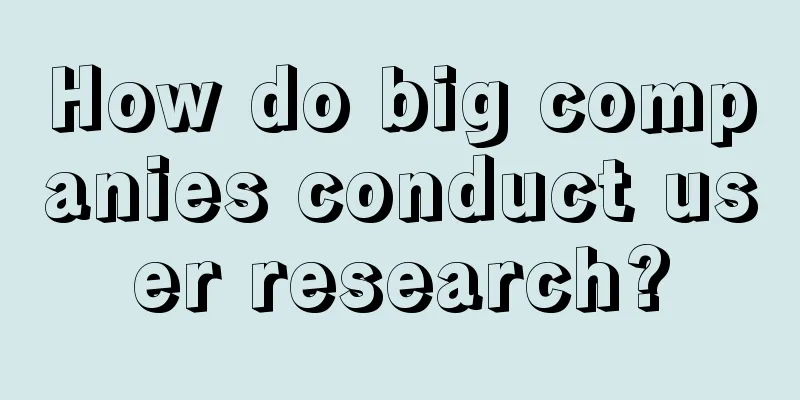How do big companies conduct user research?

It has to be said that the user research teams of large Party A companies are generally extremely luxurious due to their industry-leading position and good profitability. All the new graduates are from 985 universities or famous overseas universities, and the social recruitment is basically endorsed by well-known Party B market research companies and large Party A companies. Such a professional user research team built with a lot of money is naturally first-class in terms of user research capabilities. Many user research teams that have been established for a long time have accumulated mature and advanced user research methodology systems in a certain industry, such as the user research methodology of Tencent and NetEase Games. Today I will reveal to you how these big companies conduct user research. 1. User research workflow of large companiesThe user research teams of large companies have a very standard workflow for user research projects, which generally includes six steps: demand communication and understanding - research design - project execution and management - data collection and processing - report writing - report implementation. Demand communication and understanding. Generally speaking, the business side will first tell you what the demand is, and then the user research student responsible for supporting the business module will arrange a demand communication meeting with the business side to understand the causes and consequences of the demand at the communication meeting. The most important thing in this link is to grasp two goals: one is the business goal, also called the commercial goal, which is what business problems can be solved and what commercial value can be brought after the project is completed, such as helping to reposition the product, achieve user growth, reduce user churn, etc.; the other is the research goal, which is what content needs to be studied in order to achieve the commercial goal, such as user portraits, user purchasing and usage behaviors, user experience reputation, etc. These two goals cannot be confused. Communicating and understanding needs is actually a very difficult task. It tests the user researchers' understanding of the industry, familiarity with the business, and commercial sensitivity. They cannot just do research for the sake of research. After completing the demand communication, the user researchers of large companies will make an assessment to determine whether the demand is reasonable and valuable, and whether the time schedule allows it. If there is no problem, the business side will formally send out a demand email, which will then be reviewed and approved by the leader of the user research team and the highest person in charge of the business team. Once approved, the project can be launched. Research design: Based on the correct interpretation of the needs, the researchers began to design the research plan around two goals. This includes what research method to use, whether it is quantitative questionnaire surveys, qualitative in-depth interviews, focus group seminars or others. Some projects also require desk research combined with big data and third-party data; what the research framework and content are. For example, a feasibility study before a product is launched must at least include two major modules: product value judgment (market space and development trends of sub-categories, etc.) and user demand exploration; project execution plan, including clear outputs, reasonable time nodes, required resource support, supplier selection, etc. In this stage, in addition to the research plan, there are two important outputs, namely the questionnaire and the interview outline. If the research plan is the top-level design, then the questionnaire and the interview outline are the practical manuals. In response to different types of needs, today's large companies have already developed a set of mature research plans. Many of these are routine projects, and the research plans, questionnaires, and interview outlines all have references to past data. This is the benefit of standardization. After outputting the research plan, questionnaire, and interview outline, the user researchers of large companies will communicate with the business side again to confirm that there is no deviation from the business side's needs and goals. After confirmation, they will reply based on the demand email, and the user research team and business team leaders will conduct a second review. Project execution and management. There are two situations here: one is that there is no external supplier, and the entire project execution is completed by internal user researchers, usually mostly pure quantitative research projects, and limited to internal user research; the other is that external supplier resources are used, which generally requires the use of their user panel library or the resources and capabilities of recruiting offline users. For internal user research projects that do not use external suppliers, the process of executing the questionnaire survey is that user researchers program the questionnaire on the questionnaire platform (this questionnaire platform is particular and must be deployed locally to prevent user data leakage), then select user tags through the internal user management system, and then use text messages through the internal marketing system to reach their own users; the process of qualitative in-depth interviews and focus group seminars is to send out recruitment questionnaires and then interview users online or offline (for example, invite users to the company or visit users). When adopting user research projects from external suppliers, the suppliers will help control project time and sample quality, etc. This will make things much easier for internal user researchers, but they also need to verify samples and data to prevent fraud by the supplier. Data collection and processing. Whether it is data obtained from quantitative questionnaire surveys or user feedback obtained from qualitative in-depth interviews and seminars, there will first be a cleaning process to identify unqualified samples and remove extreme values, and then produce data tables and in-depth interview summaries and seminar summaries. Without using external suppliers, data tables are currently produced by user researchers themselves, but most of them cannot compare with the data DP of third-party market research companies. This is also the shortcoming of user researchers in the few large companies. When it comes to some advanced modeling and analysis, they are even more stretched. In-depth interview summaries and symposium summaries were originally summaries and opinions, but now the general trend is to turn them into information summaries. My previous team used Word to summarize at first, but later simply switched to Excel, putting the key content information of interviews with different users together and turning it into an information query and retrieval tool. Report writing. User research teams in large companies generally have more time to produce the final report than small and medium-sized companies. They can spend one or two weeks or even one or two months writing and revising the report, and constantly polishing it, which is something that small and medium-sized companies cannot do. Of course, they will also handle some small temporary needs promptly. User research reports from large companies are generally long, comprehensive and in-depth. On the one hand, this is the result of a long period of time and multiple rounds of fine polishing. On the other hand, they are able to integrate a variety of resources, such as purchased third-party platform data, internal big data, and support from the strategic team/business analysis team. Both the content and layout of the report are impeccable, and there is even a trend of crushing external professional market research companies. After the first version of the report is out, there will be a preliminary communication and report with the business front line, and modifications will be made based on their opinions. After a second communication to confirm that everything is correct, it will be reported upwards. As the reporting level increases, each report will bring the possibility of report adjustment, or even the complete rebuilding of the reporting framework. After completing the final report, a formal email is also sent to close the loop of the project. By the way, they will also track the implementation of the project, such as how many of the ten suggestions were finally adopted, and how the adopted ones were finally reflected in the products. 2. User Research Methodology of Large CompaniesThe user research teams of large companies pay great attention to the diversity and standardization of research methods. In terms of the diversity of research methods, in addition to traditional mainstream questionnaires, in-depth interviews, and focus group discussions, many new research methods will also be developed and applied. Cutting-edge eye tracking and brain neuroscience research are actually in use; non-mainstream methods such as online communities, user logs, and user crowd testing are also used quite frequently. Standardization construction includes project process standardization, questionnaire standardization, and project standardization. Project process standardization involves standardized operating manuals for each link, including research project establishment, quantitative + qualitative research, data processing, and project output. Questionnaire standardization will help to continuously accumulate a standardized question library based on the research project, such as the standardization of demographic attribute questions and purchase driver questions. Project standardization will accumulate the experience of many projects, including user portrait research, product innovation research, and user satisfaction/NPS evaluation, and summarize the commonalities to improve the efficiency and standardization of routine user research projects. User research conducted by large companies has formed solutions that cover the entire product life cycle.
More importantly, since the user research teams of large companies are generally established longer, they have accumulated profound project experience and, through continuous iteration and review of projects, have formed mature solutions to specific industry propositions. Take Tencent for example. In terms of user research in the gaming field, they have a set of TTRT methodologies for the proposition of how to transform classic IPs into popular mobile games. Specifically, it includes target user positioning (Target), product testing (Test), product positioning calibration (Retarget), and product testing (Test). Similarly, NetEase Games User Experience Center combines user research and game development to develop a set of standard solutions for different issues ranging from users to competitors to data and then to interactions. 3. User Research Organization Construction and Management in Large CompaniesThere is a major trend in the organizational structure of user research teams in large companies, which is to integrate industry/business analysis, big data, and user research into a comprehensive mid-tier think tank, usually called the Market and User Research Department. However, many small and medium-sized enterprises are lame. In terms of organizational affiliation, they are either affiliated with the design, brand or big data departments, and user research does not have a high status. The construction of user research teams in large companies focuses on echelons. The bottom of the pyramid is new campus recruits, starting from 985 prestigious universities, and the threshold is very high; some of the middle-level backbones are grown-up campus recruits, but more are poached from other companies through social recruitment, and they basically have to have academic qualifications and have endorsements from large companies; the top of the pyramid is the director or senior director, who generally has more than 5 years of time in the company and team and is a veteran of the team. Management personnel recruited from social recruitment are relatively rare. Managers of user research teams in large companies generally come from professional user research backgrounds, and rarely are they outsiders or leaders of other departments concurrently serving in this role. This is also a big difference from small and medium-sized enterprises. The user research teams of large companies have a mature capability model and talent assessment mechanism to grade and promote personnel. The following assessment system is used by many large companies and can be used as a reference. In terms of performance appraisal, user research teams of large companies are actually unable to achieve objective quantification, although they provide many dimensional indicators and assign different weights. For example, the weight of work results quality is 60%, team communication and collaboration is 20%, organizational influence is 20%, and so on. The weights are different for different job levels, but no matter what job level, the weight of work results quality is the highest. Moreover, when evaluating the quality of work, it is usually not the number of projects that is done that is considered, but the quality of the projects and their impact on the business side, especially the impact on the business management. The size of the user research team of large companies ranges from dozens to thousands of people (really thousands of people), and they can provide one-to-one or even many-to-one support to the business, which is unimaginable in small and medium-sized enterprises. Tencent and NetEase have hundreds of game products, and now basically one user researcher is assigned to one game product; while some large companies do not have so many products, such as mobile phone companies, which only have a few core products, so several people work together to serve one product. It is said that a person cannot make money beyond his cognition, and the same applies to businesses. These large companies are willing to pay such a high price because they are fully aware of the business value brought by user insights (cognition). Many small and medium-sized enterprises are still making decisions based on business intuition and business experience, relying on trial and error, which leads to a widening gap. The strong will always be strong, and the weak will always be weak. Author: Liu Peilong; WeChat public account: Peron |
Recommend
How long does it take for a new Amazon store to make money? How long does it take for a new Amazon store to take off?
Whether e-commerce can make money is a question th...
Five new underlying changes in brand equity
This article revolves around the concept of brand ...
Is Amazon FBM easy to do? How to reduce logistics costs by self-delivery?
Now many of you should be learning about Amazon FB...
CCTV’s magical copywriting is out!
The charm of copywriting lies in that a sentence c...
How to get a partial refund on Shopee Taiwan? What is the method?
There are more and more merchants opening stores o...
How can brands leverage “dopamine” and play with color and hot marketing?
This article systematically analyzes the marketing...
Baidu's number one public relations officer, became a Douyin influencer for 7 days
During the Labor Day holiday, Baidu's number o...
Don’t do unmanned live streaming anymore? The practitioner invested more than 30,000 yuan, but the sales volume was 0 and the account was blocked...
What is unmanned live streaming? Why is it so popu...
Xiaohongshu AIPS crowd asset model (the latest and most complete practical analysis)
In the era of digital marketing, how can brands ac...
Is it better to use RMB or USD on Shopee? What are the fees?
Friends who do cross-border e-commerce should all ...
Teach you how to dig out high-profit products from your competitors’ “behavioral paths”!
Competitors are good teachers for us to learn from...
Super detailed real-life examples of user portraits
In today's data-driven business environment, u...
Private domain traffic solutions for different enterprises
Internet traffic has peaked, but private traffic c...
Can I change my ID card when registering for Shopee? How does Shopee perform identity authentication?
To register on any e-commerce platform, merchants ...
Why can the founder make money for the company but not be able to manage it?
The founders of small and medium-sized enterprises...









